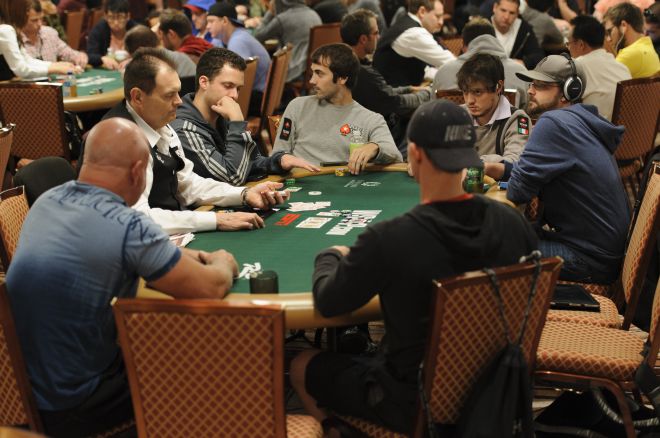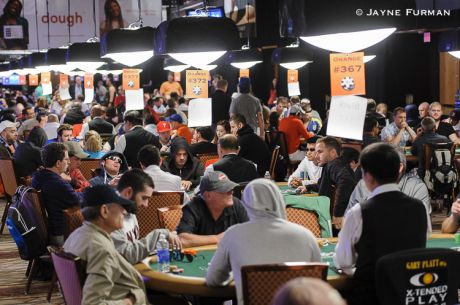Should You Play Poker with Maniacs or Find Another Game?

When I was reading Card Player magazine recently, I noticed what appeared to be a contradiction between two columnists in the same issue. I think the difference in views is worth exploring.
Ed Miller��s column was titled, ��Variance Is Your Friend.�� The main thrust of his article was to condemn poker players who try to reduce variance, because doing so means reducing your profit, too, assuming that you have a skill edge on your opponents.
��Variance is where the edges live. Nearly always, if you remove the variance from a game, you��ve also removed your edge,�� explains Miller. ��In no-limit hold��em, don��t alter your strategy in an effort to reduce your variance. You will nearly always reduce your winrate significantly at the same time. It��s no coincidence that some of the most successful poker players are also commonly characterized as ��fearless.����
Then a few pages later, we find a column by Alan Schoonmaker, ��Why You Can��t Beat Low-Limit Games: Write Strategic Plans for Individuals: II.�� Because this is part of an ongoing series, the title doesn��t reflect the content well. Schoonmaker��s main point is to avoid games that have maniacs in them. Even though there are lots of big pots, those are not good games, he says, because the presence of maniacs reduces your skill edge.
See the contradiction? Games with maniacs are unquestionably high-variance, so Miller��s advice would seem to be to embrace the opportunity that variance presents, while Schoonmaker says to find yourself a better game.
So who is right?
Answer: Both of them �� sort of.
Let��s imagine the most maniacal game possible. Every one of your nine opponents pushes all in preflop every single hand. You are the only one with some restraint, choosing whether to join the mass all-in depending on the strength of your two down cards. What strategy should you adopt?
The common answer is to tighten up from your usual strategy. That will reduce your variance, because your equity in each hand that you play is higher the closer you stick to the small set of premium starting hands. However, this approach does not maximize your profits, because you��re playing so few hands per hour.
On the other hand, if you join the maniacs and shove every hand, you have zero edge because the range of cards with which you��re betting your stack is exactly the same as theirs. The result is that all the players just trade chips, with everybody slowly losing to the house rake.
It turns out that the sweet spot for hourly profit in this artificial scenario is to play the best 35% (approximately) of your starting hands �� which is a range much broader than you could profitably play in a more sane game. Your average equity in each pot you play is then about 14%, compared to about 9.5% for each of your opponents.
That means that you��re going to lose a lot. Huge, huge variance. But over the long run, that difference in the strength of starting hands between you and your maniac friends means that chips will flow from them to you, just as surely as the ��0�� and ��00�� on the roulette wheel is all the edge the casino needs to win a boatload more money than it loses. In theory, then, if you have the bankroll to withstand the variance, you should welcome a seat in the maniac game.
But Schoonmaker is right, too, for reasons that have more to do with psychology than math. Sitting at a table with one or more maniacs drastically changes the dynamics of the game in ways that many �� perhaps most �� poker players are not prepared to handle well.
This, too, comes from the increased variance. While increased variance might mathematically increase your average hourly profit over the long run, your results in any one session might be disastrously bad. You have to be prepared to lose several buy-ins �� or even many buy-ins �� and yet continue playing optimally. Resisting tilt induced by repeated losses is difficult for nearly everyone. If you lose your cool, you lose any skill edge you started with, and spiral down both financially and emotionally.
Schoonmaker also points out that most players find it frustrating to play without some of the tools they rely on most, tools like bluffing (you can��t bluff a maniac), hand-reading (you can��t read a maniac), blind-stealing (you can��t steal from a maniac), and so on. If you��re inexperienced with the defensive, responsive kind of strategy that the maniacs force you to adopt, you��ll probably be frustrated and uncomfortable. Nobody plays well when frustrated and uncomfortable.
So what��s the bottom line? Should you embrace or shun games with high-variance maniacs in them? As with most poker questions, it depends. In particular, it depends on your bankroll, your emotional stability, and your understanding of the strategic adjustments you have to make to profit in such a game.
It might also depend on how the other players are adapting to the maniac(s). If they��re tilting badly and becoming maniacal themselves, it could further increase the volatility of the game. This might work to your favor. Think of Rudyard Kipling��s famous line, ��If you can keep your head when all about you are losing theirs��.�� But the chaos and frenzy might sweep you into its vortex and suck you down to the depths.
I have historically done reasonably well in maniac games. I don��t seek them out, because I find them draining rather than relaxing and enjoyable. But I don��t run away from them, either. Only you can decide whether trying to hang on for the wild ride is worthwhile for you and your particular circumstances, bankroll, and psychology. Choose well.
Robert Woolley lives in Asheville, NC. He spent several years in Las Vegas and chronicled his life in poker on the ��Poker Grump�� blog.
Want to stay atop all the latest in the poker world? If so, make sure to get PokerNews updates on your social media outlets. Follow us on Twitter and find us on both Facebook and Google+!









